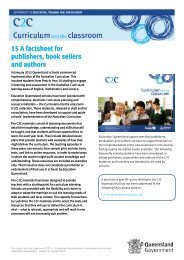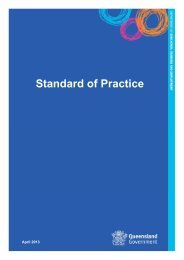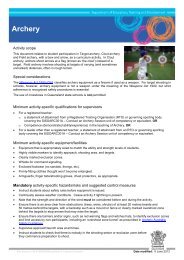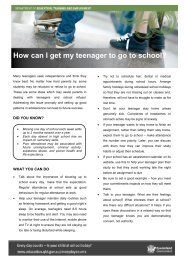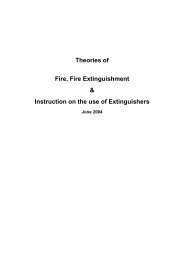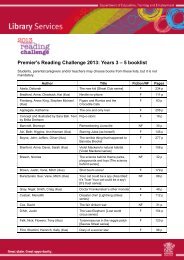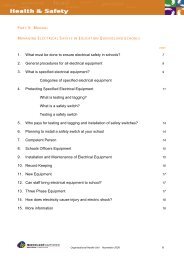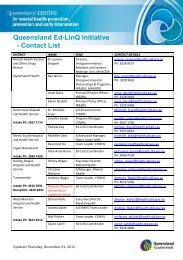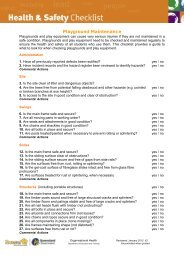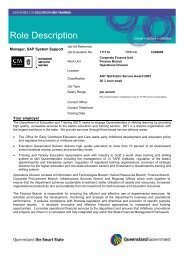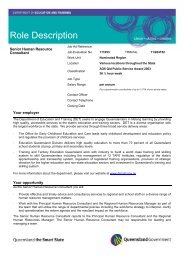Anaphylaxis guidelines for Queensland State Schools - Education ...
Anaphylaxis guidelines for Queensland State Schools - Education ...
Anaphylaxis guidelines for Queensland State Schools - Education ...
You also want an ePaper? Increase the reach of your titles
YUMPU automatically turns print PDFs into web optimized ePapers that Google loves.
<strong>Anaphylaxis</strong> <strong>guidelines</strong> <strong>for</strong><br />
<strong>Queensland</strong> state schools<br />
Last updated February 2013
Foreword<br />
The <strong>Queensland</strong> Department of <strong>Education</strong>, Training and Employment is committed to ensuring the health,<br />
safety and wellbeing of all students in <strong>Queensland</strong> state schools. A vital component of this commitment is<br />
to ensure that state schools are provided with current advice to support students with health conditions to<br />
engage in the full range of school-based activities.<br />
The <strong>Anaphylaxis</strong> Guidelines <strong>for</strong> <strong>Queensland</strong> <strong>State</strong> <strong>Schools</strong> provide specific in<strong>for</strong>mation <strong>for</strong> <strong>Queensland</strong><br />
state schools on how to manage and treat students with severe allergies who are at risk of anaphylaxis.<br />
They are also relevant to support staff, visitors or previously undiagnosed students who require emergency<br />
first aid in response to an anaphylactic reaction.<br />
These Guidelines should be read in conjunction with:<br />
• The Management of Students with Specialised Health Needs procedure which provides practices <strong>for</strong><br />
schools to ensure that students have access to a reasonable standard of support <strong>for</strong> their health need/s<br />
whilst attending school or school-based activities.<br />
• The Administration of Medications in <strong>Schools</strong> procedure which explains the roles and responsibilities <strong>for</strong><br />
schools in storing and administering medication.<br />
2 <strong>Anaphylaxis</strong> <strong>guidelines</strong> <strong>for</strong> <strong>Queensland</strong> state schools
Contents<br />
Foreword...................................................................................................................................................... 2<br />
1. What is anaphylaxis? ................................................................................................................................... 4<br />
2. Duty of care .................................................................................................................................................. 4<br />
3. <strong>Anaphylaxis</strong> Action Plans ............................................................................................................................. 6<br />
4. Signs and symptoms of anaphylaxis ............................................................................................................ 7<br />
5. Equipment <strong>for</strong> anaphylactic emergencies ................................................................................................... 8<br />
5.1 Student’s equipment ............................................................................................................................. 8<br />
5.2 School emergency equipment ............................................................................................................... 8<br />
5.3 School purchase of adrenaline auto-injectors ....................................................................................... 9<br />
6. Risk management ...................................................................................................................................... 10<br />
6.1 Identifying the risks.............................................................................................................................. 10<br />
6.2 Minimising the risks ............................................................................................................................. 11<br />
6.3 Preparing <strong>for</strong> an emergency event ...................................................................................................... 15<br />
7. School emergency treatment procedure ................................................................................................... 16<br />
7.1 Considerations in developing a school emergency procedure ............................................................ 16<br />
8. Roles and responsibilities of the principal ................................................................................................. 19<br />
8.1 Identifying the risks.............................................................................................................................. 19<br />
8.2 Minimising the risks ............................................................................................................................. 19<br />
8.3 Developing a school emergency response procedure ......................................................................... 23<br />
9. Roles and responsibilities of the teacher ................................................................................................... 23<br />
10. Roles and responsibilities of the first aid officer ..................................................................................... 24<br />
11. Roles and responsibilities of the tuckshop staff ...................................................................................... 25<br />
12. Roles and responsibilities of the parent .................................................................................................. 26<br />
References ..................................................................................................................................................... 27<br />
Acknowledgements ....................................................................................................................................... 27<br />
3 <strong>Anaphylaxis</strong> <strong>guidelines</strong> <strong>for</strong> <strong>Queensland</strong> state schools
1. What is anaphylaxis?<br />
<strong>Anaphylaxis</strong> is a severe and sudden allergic reaction. It occurs when a person is exposed to an allergen to<br />
which they are sensitive.<br />
Allergens or trigger substances that may cause anaphylaxis in school-aged children are:<br />
Peanuts<br />
Tree nuts<br />
Insect stings<br />
Shellfish<br />
Fish<br />
Certain<br />
medications<br />
Eggs<br />
Cow’s milk<br />
Peanuts<br />
Other potential allergens may include soy, sesame, wheat, seeds,<br />
coconut and latex. The Australasian Society of Clinical Immunology<br />
and Allergy has details of a wide range of allergens within their<br />
<strong>Anaphylaxis</strong> Resources <strong>for</strong> patients and consumers at<br />
http://www.allergy.org.au/patients<br />
4 <strong>Anaphylaxis</strong> <strong>guidelines</strong> <strong>for</strong> <strong>Queensland</strong> state schools
2. Duty of care<br />
<strong>Education</strong> authorities have a duty of care to take reasonable steps to keep students safe at school. This<br />
includes minimising the risk of personal injury to students, seeking medical assistance and administering<br />
emergency medication when a student has signs and symptoms of anaphylaxis.<br />
First aid requirements <strong>for</strong> all schools<br />
All <strong>Queensland</strong> state schools, including departmental outdoor and environmental education<br />
centres, have the responsibility of administering emergency first aid which may include a<br />
response to a first time episode of anaphylaxis. <strong>Queensland</strong> state schools are required to:<br />
• maintain a minimum of one school adrenaline auto-injector stored within a school first aid<br />
kit<br />
• determine, through a risk assessment process, the purchase of any additional autoinjectors<br />
• ensure relevant staff members (e.g. first aid officers) are trained in anaphylaxis<br />
management and in administering an adrenaline auto-injector.<br />
Specific requirements to cater <strong>for</strong> diagnosed students<br />
<strong>Schools</strong> with a student diagnosed at risk of anaphylaxis should:<br />
• ensure sufficient staff members are trained in anaphylaxis management<br />
• be familiar with students’ Action Plan <strong>for</strong> <strong>Anaphylaxis</strong><br />
• be familiar with the <strong>Anaphylaxis</strong> Guidelines <strong>for</strong> <strong>Queensland</strong> <strong>State</strong> <strong>Schools</strong><br />
• be aware of the roles and responsibilities of parents, the principal (or site administrator),<br />
school staff and students<br />
• develop an <strong>Anaphylaxis</strong> Risk Management Plan.<br />
5 <strong>Anaphylaxis</strong> <strong>guidelines</strong> <strong>for</strong> <strong>Queensland</strong> state schools
3. <strong>Anaphylaxis</strong> Action Plans<br />
A student with diagnosed anaphylaxis or mild to moderate allergic reactions<br />
should have an Action Plan completed by their medical practitioner. Action<br />
Plans are standardised templates developed by the Australasian Society of<br />
Clinical Immunology and Allergy (ASCIA), available on their website and<br />
detail how to manage a patient’s allergic reaction should it occur.<br />
Action Plan <strong>for</strong><br />
EpiPen®<br />
There are a number of different Action Plan templates<br />
which are colour coded to indicate the severity of the<br />
allergic reaction and the type of medication or<br />
adrenaline auto-injector the patient may use.<br />
Action Plan<br />
<strong>for</strong> Anapen®<br />
Action Plan <strong>for</strong><br />
Allergic Reactions<br />
Action Plan <strong>for</strong> <strong>Anaphylaxis</strong> (general)<br />
There is also an Action Plan <strong>for</strong><br />
<strong>Anaphylaxis</strong> (general), which<br />
provides standard emergency procedures <strong>for</strong> anaphylaxis and<br />
can be used as a poster or to accompany an adrenaline autoinjector<br />
<strong>for</strong> general use in a first aid kit.<br />
Action Plans are available http://www.allergy.org.au/healthprofessionals/anaphylaxis-resources/ascia-action-plan-<strong>for</strong>anaphylaxis<br />
6 <strong>Anaphylaxis</strong> <strong>guidelines</strong> <strong>for</strong> <strong>Queensland</strong> state schools
4. Signs and symptoms of anaphylaxis<br />
The signs and symptoms of anaphylaxis usually occur within the first 20 minutes after exposure to an<br />
allergen but in some cases can be delayed up to two hours or more. Rapid onset and development of<br />
potentially life-threatening clinical effects are characteristic markers of anaphylaxis. The following are<br />
typical signs and symptoms of allergic reactions. The student’s Action Plan <strong>for</strong> <strong>Anaphylaxis</strong> (Action Plan)<br />
will provide in<strong>for</strong>mation specific to their health condition.<br />
Anaphylactic reaction (severe allergic reaction)<br />
Signs and symptoms of anaphylaxis may include one or more of the following:<br />
• difficulty talking and/or hoarse voice<br />
• difficult/noisy breathing<br />
• swelling of the tongue<br />
• swelling or tightness in the throat, difficulty in swallowing<br />
• confusion<br />
• pale and floppy (<strong>for</strong> young children)<br />
• shortness of breath, repetitive coughing and/or wheezing<br />
• chest tightness<br />
• faint, rapid pulse, low blood pressure (may also have cool sweaty skin)<br />
• loss of consciousness and/or collapse<br />
• vomiting, abdominal pain (<strong>for</strong> insect sting allergy).<br />
Mild to moderate allergic reaction<br />
Signs and symptoms of a mild to moderate allergic reaction may include one or more of the<br />
following:<br />
• tingling of the mouth<br />
• hives, welts or body redness<br />
• flushing and/or swelling of the face, lips, eyes<br />
• anxiety<br />
• vomiting, abdominal pain (except in insect sting allergy where vomiting and/or<br />
abdominal pain indicate an anaphylactic reaction).<br />
7 <strong>Anaphylaxis</strong> <strong>guidelines</strong> <strong>for</strong> <strong>Queensland</strong> state schools
5. Equipment <strong>for</strong> anaphylactic emergencies<br />
5.1 Student’s equipment<br />
Each student diagnosed to be at risk of anaphylaxis should have their own anaphylaxis emergency kit. This<br />
kit contains:<br />
• their personal adrenaline auto-injector (EpiPen® or Anapen®) to administer if required<br />
• their red ASCIA Action Plan <strong>for</strong> <strong>Anaphylaxis</strong> (personal) to provide<br />
personalised instructions<br />
• a pencil and blank paper to write down the exact time of administration<br />
to provide to the paramedics<br />
• The storage of the student’s anaphylaxis emergency kit will be<br />
determined by the school in consultation with the parent and student<br />
after careful consideration of the risks involved.<br />
Example of student’s<br />
anaphylaxis emergency kit<br />
5.2 School emergency equipment<br />
All schools are required to maintain a minimum of one back-up adrenaline<br />
auto-injector and determine, through a risk assessment process, the purchase of any additional autoinjectors,<br />
taking into consideration factors such as:<br />
• the number of students enrolled who have been medically diagnosed as being at risk of anaphylaxis<br />
• the location of the first aid kit and the proximity to each student's classroom, playground area, sports<br />
field<br />
• the accessibility of backup auto-injector/s during school excursions and camps<br />
• the level of risk in the environment (e.g. increased exposure to potential allergens and distance from<br />
emergency services).<br />
The school’s adrenaline auto-injector should be stored with a copy of an ASCIA Action Plan <strong>for</strong><br />
<strong>Anaphylaxis</strong> (general), which provides standard emergency procedures <strong>for</strong> anaphylaxis. An ASCIA Action<br />
Plan <strong>for</strong> <strong>Anaphylaxis</strong> (general) is available at http://www.allergy.org.au/health-professionals/anaphylaxisresources/ascia-action-plan-<strong>for</strong>-anaphylaxis<br />
8 <strong>Anaphylaxis</strong> <strong>guidelines</strong> <strong>for</strong> <strong>Queensland</strong> state schools
The school’s adrenaline auto-injector <strong>for</strong> general use may be used to cover situations when:<br />
• a second dose of adrenaline is required after the<br />
administration of the student’s prescribed auto-injector<br />
• the first dose of adrenaline has not been able to be<br />
successfully administered due to failure of the adrenaline autoinjector<br />
or misfire<br />
• a student not previously diagnosed presents with signs and<br />
symptoms of anaphylaxis<br />
• a visitor (child/adult) to the school presents with symptoms of<br />
anaphylaxis.<br />
Example of school first aid<br />
5.3 School purchase of adrenaline auto-injectors<br />
Authorisation has been provided by <strong>Queensland</strong> Health under Section 18(1) of the Health (Drugs and<br />
Poisons) Regulation 1996 <strong>for</strong> the principal to obtain adrenaline as an auto-injector <strong>for</strong> the purpose of<br />
providing emergency medication to students and staff <strong>for</strong> the treatment of anaphylaxis.<br />
Under this authorisation, available at<br />
http://education.qld.gov.au/schools/healthy/docs/queensland_health_approval_adrenaline_auto_injectors.p<br />
df , schools are able to purchase adrenaline auto-injectors from a pharmacist or licensed wholesaler of<br />
drugs or poisons on the signed written order of the principal and provision of a copy of the <strong>Queensland</strong><br />
Health approval letter.<br />
Other conditions <strong>for</strong> school purchase of an auto-injector by <strong>Queensland</strong> Health include:<br />
• storing it in the school’s first aid kit<br />
• storing it in accordance with directions by the manufacturer regarding temperature control<br />
• administering it by staff in accordance with the school’s emergency protocol<br />
• providing appropriate training to staff in administering the auto-injector.<br />
The shelf life of an adrenaline auto-injector is normally between 1 to 2 years. Prior to purchasing a new or<br />
replacement auto-injector, check with the pharmacy to ensure the auto-injector has maximum shelf life.<br />
9 <strong>Anaphylaxis</strong> <strong>guidelines</strong> <strong>for</strong> <strong>Queensland</strong> state schools
6. Risk management<br />
Episodes of anaphylaxis are unpredictable and accidental exposure is a reality.<br />
There is no one rule <strong>for</strong> all schools or all students at risk of anaphylaxis.<br />
Where a student is known to be at risk of anaphylaxis, the principal is responsible <strong>for</strong> the health care<br />
management of this specialised health need. There are three stages in managing anaphylaxis in a school<br />
setting:<br />
1. Identifying the risks<br />
2. Minimising the risks<br />
3. Preparing <strong>for</strong> an emergency event.<br />
6.1 Identifying the risks<br />
When the school is notified that a student is at risk of anaphylaxis, the first step in managing the risk is to<br />
identify:<br />
• the student’s capabilities<br />
• the student’s allergic triggers<br />
• the level of anaphylaxis training provided to school staff<br />
• situations where there may be increased risk to the student.<br />
Student’s capabilities<br />
Young students or students with disability may require more targeted support. Older, more independent<br />
students are more likely to identify their own signs and symptoms of an anaphylactic emergency and raise<br />
the alarm. However, it is vital that school staff are aware of all students who are at risk of anaphylaxis and<br />
the school’s planning to support these students.<br />
Student’s allergic triggers<br />
Students may be potentially exposed to their allergens during school-based activities so it is vital to identify<br />
these triggers and their frequency in the environment as this will impact on curriculum activity planning.<br />
Some allergies such as drug allergies may have minimal impact on the daily operations of the school, so<br />
minimizing exposure may be personalised to the individual student (e.g. advising paramedics if the student<br />
is allergic to drugs in an emergency). However severe allergies to foods and insects, which are two of the<br />
most common causes of anaphylaxis, affect and may be affected by the whole school community, there<strong>for</strong>e<br />
planning will require whole-school strategies.<br />
As students can be allergic to several foods it is not possible, nor practical, to remove all food allergens<br />
from schools. Nor is it possible to remove all insects that students are allergic to. <strong>Schools</strong> can, however,<br />
implement strategies to reduce exposure to these allergens.<br />
It is important to know the severity of the student’s allergy and how quickly they are affected in order to plan<br />
the most effective emergency response.<br />
10 <strong>Anaphylaxis</strong> <strong>guidelines</strong> <strong>for</strong> <strong>Queensland</strong> state schools
The level of anaphylaxis training provided to school staff<br />
The level of risk to students being exposed to a potential allergen is reduced if staff:<br />
• understand the student’s condition<br />
• are able to assess potential risks to the student during school-based activities<br />
• are trained in recognising signs and symptoms of anaphylaxis<br />
• are trained and confident in administering an adrenaline auto-injector.<br />
Situations where there may be increased risk to the student<br />
The risks to students with anaphylaxis may increase when there are changes to:<br />
• the school routine (e.g. relief teachers, special events)<br />
• the student’s environment (e.g. camps or excursions)<br />
• the students’ health in<strong>for</strong>mation (e.g. new allergic triggers <strong>for</strong> student have been identified).<br />
6.2 Minimising the risks<br />
Develop an <strong>Anaphylaxis</strong> Risk Management Plan<br />
To ensure that students at risk of anaphylaxis are given every opportunity to participate in the full range of<br />
school activities, potential risks in the student’s school routine and environment should be assessed using<br />
the <strong>Anaphylaxis</strong> Risk Management Plan.<br />
A comprehensive <strong>Anaphylaxis</strong> Risk Management Plan which addresses the needs of students with severe<br />
allergies is an essential part of the school’s risk management. The plan will include risk minimisation<br />
strategies and consider changes to the student’s routine and environment.<br />
The plan assists staff and others involved with the students to plan <strong>for</strong> emergency situations and minimise<br />
risks associated with the student’s condition, their equipment and medication requirements.<br />
To identify potential risks in the school environment and implement risk management strategies,the<br />
<strong>Anaphylaxis</strong> Risk Management Plan should be developed by the school in consultation with:<br />
• supervising teachers<br />
• the parent<br />
• a qualified health practitioner<br />
• the student (where applicable).<br />
Completing an <strong>Anaphylaxis</strong> Risk Management Plan involves identifying and minimising students’ exposure<br />
to potential allergens which may occur during school activities and utilising this in<strong>for</strong>mation to in<strong>for</strong>m<br />
curriculum planning. To assist in completing the <strong>Anaphylaxis</strong> Risk Management Plan, consider the<br />
following most common factors which may lead to an anaphylactic event and recommended risk<br />
minimisation strategies.<br />
11 <strong>Anaphylaxis</strong> <strong>guidelines</strong> <strong>for</strong> <strong>Queensland</strong> state schools
Common factors and risk minimisation<br />
Changes to student’s health in<strong>for</strong>mation<br />
Where there are changes to in<strong>for</strong>mation<br />
about the student’s health (e.g. the student<br />
has a new allergic trigger), this will need to<br />
be communicated to staff and risks<br />
reassessed.<br />
Sickbay<br />
Students should not be left alone when<br />
complaining of feeling unwell, even in the<br />
sickbay/sick room. Their complaint should be<br />
taken seriously as their condition can<br />
deteriorate quickly.<br />
Special events<br />
During special school events,<br />
e.g. sports carnivals, red food<br />
days, there may be risks in<br />
students consuming unlabelled<br />
foods such as bakery products<br />
or food cooked and supplied<br />
from homes of other students.<br />
Special items can be supplied<br />
by the parent of the student at<br />
risk of anaphylaxis and stored in<br />
the freezer or tuckshop in a<br />
container clearly marked with<br />
the student's name <strong>for</strong> such<br />
occasions.<br />
Relief teachers<br />
Students with anaphylaxis should always be under the supervision of a teacher or designated<br />
person who has completed anaphylaxis training and who knows the student has an allergy, can<br />
recognise signs and symptoms of a reaction and knows how to use the adrenaline auto-injector in<br />
an emergency. If a relief teacher is supervising the class and has not had anaphylaxis training, the<br />
school must determine how the student will be supported (e.g. ensuring the student has access to a<br />
trained staff member who can support them should a student experience anaphylaxis).<br />
12 <strong>Anaphylaxis</strong> <strong>guidelines</strong> <strong>for</strong> <strong>Queensland</strong> state schools
Change of environment (e.g. camps, excursions or sporting events)<br />
Ensure consideration is given to students participating in excursions, camps, sports<br />
carnivals or other activities where the students are in a new environment.<br />
Supervising staff <strong>for</strong> these events need to:<br />
• know which students are at risk of anaphylaxis and their known allergens<br />
• provide relevant in<strong>for</strong>mation to excursion/camp/event site coordinators (e.g.<br />
outdoor education centres) to in<strong>for</strong>m planning of the events to enable a risk<br />
assessment of activities and the environment to occur<br />
• ensure adequate staff in attendance are trained in anaphylaxis management<br />
including the use of an auto-injector.<br />
• consider the distance from the school, camp or location of a school activity to<br />
an ambulance service or medical treatment<br />
• consider the emergency first aid equipment required and the distance of the first<br />
aid equipment from the at-risk student during activities<br />
• make the menu, medical support, environment and other location details of<br />
school camps available to the student and parents well ahead of the<br />
camp/excursion date to allow time to consider risks and suggest safety actions<br />
• know what risk minimisation strategies are in place to support the student<br />
• consider issues such as the administration of prescribed emergency medication<br />
and risk management strategies when planning an excursion/camp<br />
• have the student’s anaphylaxis emergency kit readily available and stored out<br />
of direct heat, but not on ice<br />
• know when and how to give the adrenaline auto-injector<br />
• be aware of the campsite’s procedure in the event of a medical emergency<br />
• ensure a broad range mobile phone is available when away from landline<br />
phone facilities<br />
• encourage at-risk students, who are capable, to manage their own risk as much<br />
as possible, but ensure that support is available to the student if required.<br />
13 <strong>Anaphylaxis</strong> <strong>guidelines</strong> <strong>for</strong> <strong>Queensland</strong> state schools
Camps and food allergies<br />
When planning a school camp which a student with a severe food allergy will attend, the<br />
implementation of blanket food bans or attempts to prohibit the entry of food substances at the<br />
camp is not recommended, as it cannot be policed adequately and can lead to a false sense of<br />
security. However, it is very important to consider all risks, include the parent/s in the planning<br />
process and implement workable risk minimisation strategies. Strategies to reduce risk, such as<br />
hand washing (include washing of food preparation equipment to avoid cross contamination) and<br />
no food sharing, should also be implemented.<br />
Food allergens<br />
• Implement age appropriate avoidance strategies <strong>for</strong> routine and non-routine activities (such as<br />
meal times, cooking, art, sport days, special occasions, excursions and camps).<br />
• Identify foods used in activities that contain known allergens and replace with other suitable<br />
foods.<br />
• Avoid sharing food or eating utensils (close supervision may be required at meal times <strong>for</strong><br />
younger students).<br />
• Keep surfaces clean and prevent cross-contamination during handling, preparation and serving<br />
of food.<br />
• Promote good communication between parents, staff and students.<br />
Refer to further in<strong>for</strong>mation on food allergies and dietary alternatives at<br />
http://www.allergy.org.au/patients/food-allergy<br />
14 <strong>Anaphylaxis</strong> <strong>guidelines</strong> <strong>for</strong> <strong>Queensland</strong> state schools
Insects<br />
• Specify play areas that are lowest risk and encourage the students to play in this area.<br />
• Decrease the number of plants in school grounds that are known to attract stinging insects or<br />
ticks.<br />
• Increase vigilance in areas where flowering plants are located, e.g. school kitchen gardens.<br />
• Ensure students wear appropriate clothing and shoes when outdoors.<br />
• Be aware of bees in pools, around water and in grassed or garden areas.<br />
• Avoid drinking from open drink containers, particularly those that contain sweet drinks.<br />
• To help prevent tick bites, cover skin and shake clothing once indoors.<br />
• Ensure school grounds people regularly inspect, treat and remove insect nests as required.<br />
• Refer to further in<strong>for</strong>mation on insect and tick allergy at<br />
http://www.allergy.org.au/patients/insect-allergy-bites-and-stings<br />
6.3 Preparing <strong>for</strong> an emergency event<br />
Through implementing risk minimisation strategies, the likelihood of a student experiencing an anaphylactic<br />
event should be reduced. However, exposure to potential allergens cannot be guaranteed, so the<br />
development of a school emergency treatment procedure is essential.<br />
15 <strong>Anaphylaxis</strong> <strong>guidelines</strong> <strong>for</strong> <strong>Queensland</strong> state schools
7. School emergency treatment procedure<br />
The Department of <strong>Education</strong>, Training and Employment (DETE) aims to provide a safe and secure<br />
environment <strong>for</strong> all students, staff and volunteers who work or participate in <strong>Queensland</strong> state schools.<br />
Effective planning and management of emergencies is essential within schools to help reduce potential<br />
loss of life and, after the event, allow teaching and learning to be maintained or resumed as a priority.<br />
Whilst the following procedure is specific to treating students, it can be followed in the event of an adult or<br />
visitor to the school experiencing an anaphylactic reaction.<br />
Delays in giving emergency medication or contacting emergency services can result in<br />
deterioration and death, there<strong>for</strong>e the priority actions are to treat the student and phone<br />
emergency services from the site.<br />
7.1 Considerations in developing a school emergency procedure<br />
In responding to an anaphylactic incident, a well-developed school emergency procedure should enable<br />
the situation to be managed promptly and efficiently. All staff should be familiar with the school’s<br />
emergency procedure which should be considered as part of the <strong>Anaphylaxis</strong> Risk Management Plan.<br />
School-based emergency procedures should be developed with reference to:<br />
• the Critical Incident Reference Guide <strong>for</strong> Accident/Injury <strong>for</strong> workplace health and safety procedures<br />
• the First Aid Guideline <strong>for</strong> advice regarding emergency procedures and first aid, emergency<br />
medication, and the procedure <strong>for</strong> calling an ambulance in an emergency.<br />
Although schools vary in size and layout, the following considerations can assist in the development of a<br />
localised school emergency procedure.<br />
Priority arrangements<br />
• Understand that owing to the need <strong>for</strong> the <strong>Queensland</strong> Ambulance Services to monitor<br />
the patient’s condition, the ambulance should be called by a person nearest to the<br />
patient rather than from the school office if possible.<br />
• Determine who will administer medication and who will phone emergency services, e.g.<br />
will a teacher administer and the teacher-aide phone, or will the teacher administer and<br />
make the call. Student supervision is likely to vary during the school day which should<br />
be taken into account.<br />
• Determine the procedure to raise the alarm with the office, e.g. will a teacheraide/student<br />
phone the office using the classroom intercom or a student run an alert<br />
card from the oval/kitchen garden to the office?<br />
16 <strong>Anaphylaxis</strong> <strong>guidelines</strong> <strong>for</strong> <strong>Queensland</strong> state schools
The class/other students<br />
• Consider who will supervise other students whilst first aid treatment is being given.<br />
• Consider the noise level of class groups and, if this will interfere with clear<br />
communication with the 000 dispatcher, possible evacuation to an alternative area <strong>for</strong><br />
these students in an anaphylactic emergency.<br />
Providing first aid to the student<br />
• Ensure a student demonstrating signs of allergy or anaphylaxis is not left alone.<br />
• Provide immediate treatment of the student in accordance with their Action Plan (or as a<br />
first aid response <strong>for</strong> a previously undiagnosed student) and contact emergency services<br />
as the first two priority actions.<br />
• Ensure staff supervision has been organised <strong>for</strong> a student who is authorised to selfadminister<br />
in the event that self-administration fails.<br />
The location in which the anaphylactic event may occur<br />
• Consider the number of adults available to coordinate the procedure in various locations.<br />
• Consider location of and access to phones and/or intercoms during school-based<br />
activities, e.g. during lunch breaks there may be no access to intercoms/landline<br />
telephones as classrooms may be locked.<br />
17 <strong>Anaphylaxis</strong> <strong>guidelines</strong> <strong>for</strong> <strong>Queensland</strong> state schools
The role of administrative staff<br />
• The school administration plays a vital role in managing an emergency incident.<br />
• If the school first aid kit which contains the school’s adrenaline auto-injector is located in<br />
the office, determine who will be responsible <strong>for</strong> delivering to the site of the incident.<br />
• Determine who will guide the ambulance to the emergency site.<br />
• Consider the time of day and how this would impact on directing emergency services,<br />
eg. during lunchtime students may need to be cleared from emergency routes.<br />
• Determine if and how additional adults can support staff at the incident, e.g. providing<br />
supervision to other students, redirecting students away from the incident.<br />
• Determine who will phone the parent regarding the incident.<br />
• Consider who will take over various responsibilities if staff are absent.<br />
Dialing emergency services<br />
• Is a mobile phone available <strong>for</strong> use and does it have reception?<br />
• Are staff aware that if they are calling from a mobile phone and 000 does not work, 112 is<br />
an alternative?<br />
• Are staff aware that emergency calls are free calls?<br />
18 <strong>Anaphylaxis</strong> <strong>guidelines</strong> <strong>for</strong> <strong>Queensland</strong> state schools
8. Roles and responsibilities of the principal<br />
The role of the principal will involve being familiar with the <strong>Anaphylaxis</strong> Guidelines <strong>for</strong> <strong>Queensland</strong> state<br />
schools in order to:<br />
• work with the school community to identify and minimise the risks associated with students diagnosed at<br />
risk of anaphylaxis and develop school-based planning <strong>for</strong> emergency responses<br />
• ensure the school has emergency first aid procedures, equipment and trained staff in place to cater <strong>for</strong><br />
potential first time (undiagnosed) episodes of anaphylaxis.<br />
8.1 Identifying the risks<br />
The key role of the principal is to:<br />
• seek in<strong>for</strong>mation from the parent about the allergies that affect the student as part of the health<br />
in<strong>for</strong>mation collected at enrolment and as part of regular health updates<br />
• discuss with the parent the capabilities of the student to recognise their own symptoms and alert others<br />
• identify the number of staff who are trained in anaphylaxis management.<br />
8.2 Minimising the risks<br />
Communicate with parents of students with anaphylaxis<br />
• Ensure that the parent supplies the school with the student’s Action Plan, completed and signed by the<br />
student’s medical practitioner, along with a personal adrenaline auto-injector <strong>for</strong> the student.<br />
• Request that the parent approves the sharing of in<strong>for</strong>mation regarding the student’s health condition<br />
with staff and relevant school volunteers.<br />
• Refer parents to Section 12 of these Guidelines to discuss the roles and responsibilities of the parent.<br />
Complete risk management planning<br />
• Consult with the parent, relevant staff, the student and relevant community members to develop a<br />
whole-of-school <strong>Anaphylaxis</strong> Risk Management Plan to assess potential risks in the student’s routine,<br />
minimise risks and reduce the risk of accidental exposure. This will ensure that students at risk of<br />
anaphylaxis are given every opportunity to participate in a full range of school activities.<br />
• Discuss with supervising staff the scenarios where there may be increased risk to the student being<br />
exposed to a potential allergen and identify strategies to reduce the risk and refer to Section 6 and<br />
Section 7 of these Guidelines to in<strong>for</strong>m discussions.<br />
Plan anaphylaxis risk minimisation strategies with school staff<br />
• Advise staff of all students with anaphylaxis who are enrolled in the school, their triggers and the risk<br />
management strategies to be implemented.<br />
• Ensure that students’ medical in<strong>for</strong>mation will only be accessed by authorised departmental employees<br />
and the in<strong>for</strong>mation will not be disclosed to any other person or body unless the parent has given<br />
consent or the Department is required or authorised by law.<br />
• Where parental permission has been given:<br />
- provide staff with in<strong>for</strong>mation about the individual student's severe allergy including copies of their<br />
Action Plan<br />
19 <strong>Anaphylaxis</strong> <strong>guidelines</strong> <strong>for</strong> <strong>Queensland</strong> state schools
- ensure that copies of the student’s Action Plan is placed in appropriate locations across the school<br />
to alert all staff to the student’s health condition and appropriate emergency response.<br />
• Ensure staff provide age-appropriate education to students regarding severe allergies. Age-appropriate<br />
peer education is important in reducing the risk of exposure. Peers are also able to alert teaching staff if<br />
they see a student with a history of allergy looking unwell.<br />
(See http://www.allergyfacts.org.au/links/online-store).<br />
• Ensure staff who supervise a student with anaphylaxis are confident in developing safe school activities<br />
which minimise exposure to known allergens.<br />
• Advise staff of students who have been given approval to self-administer and the conditions surrounding<br />
this.<br />
Organise staff training<br />
• Ensure a range of staff have completed the online ASCIA anaphylaxis e-training course <strong>for</strong> <strong>Schools</strong> and<br />
Childcare (<strong>Queensland</strong> version) at https://etraining.allergy.org.au/ and undergone practical training in<br />
the use of adrenaline auto-injectors (EpiPen® and Anapen®).<br />
• Ensure sufficient numbers of staff members have current first aid training (which includes<br />
cardiopulmonary resuscitation (CPR) and the administration of emergency asthma medication).<br />
• Consider the following when determining how many staff are to be trained:<br />
- the number of students diagnosed at risk of anaphylaxis<br />
- the curriculum and out-of-school activities in which these students participate<br />
- the level of associated risk with these activities<br />
- the impact of sick leave or other absences on staff availability<br />
- the ratio of trained staff required to meet the school’s emergency first aid response in the event of a<br />
first time presentation of anaphylaxis.<br />
• Consider the following personnel <strong>for</strong> training in emergency response to and treatment of anaphylaxis:<br />
- all staff who teach students who are at risk of anaphylaxis, including those who supervise specialist<br />
classes, non-contact time, elective classes and extracurricular activities including music<br />
- sports/physical education teachers including staff who supervise sports such as after-school<br />
practice/training sessions and interschool sport where relevant<br />
- teachers who deliver cooking lessons<br />
- science teachers<br />
- staff attending camps and/or excursions, special event days such as sport, music, per<strong>for</strong>ming arts,<br />
walkathons and cultural days<br />
- teacher aides<br />
- designated first aid officers<br />
- front office staff who are the first point of contact <strong>for</strong> visitors to the school<br />
- staff who supervise 'detention' sessions, eating and playground areas<br />
- tuckshop convenor and regular tuckshop helpers<br />
- relief staff<br />
- groundspeople.<br />
20 <strong>Anaphylaxis</strong> <strong>guidelines</strong> <strong>for</strong> <strong>Queensland</strong> state schools
• Maintain a register of staff who participate in the practical training component. Principals should review<br />
staff requirements <strong>for</strong> access to the online training course and practical training in the use of the<br />
adrenaline auto-injectors.<br />
Select anaphylaxis first aid trainers<br />
• <strong>Education</strong> <strong>Queensland</strong> Registered Nurses (EQRNs) are employed by the Department to support<br />
schools to manage students with anaphylaxis. They provide practical training sessions in administering<br />
auto-injectors and school-based risk management strategies at no cost to the school.<br />
• Practical training may also be facilitated through a range of providers such as:<br />
- first aid organisations such as Red Cross, <strong>Queensland</strong> Ambulance Service, St. John’s Ambulance<br />
- accredited private Registered Nurses<br />
- Registered Training Organisations.<br />
• Considerations when choosing a training provider <strong>for</strong> the practical use of adrenaline auto-injectors<br />
include ensuring that they:<br />
- are appropriately qualified in the operation of the current adrenaline auto-injectors and provide a<br />
“hands on” demonstration and staff practice.<br />
- are appropriately indemnified<br />
- are Blue Card holders if trainers will be unsupervised in the presence of students<br />
- have an awareness and understanding of Administration of Medications in <strong>Schools</strong>, Management<br />
of Students with Specialised Health Needs and related procedures.<br />
Develop or review anaphylaxis emergency procedures with school staff<br />
• Ensure all staff are aware of who is trained in administering adrenaline auto-injectors in the school and<br />
where the school’s auto-injector/s are located.<br />
• Ensure all staff who supervise students at risk of anaphylaxis are familiar with their Action Plans.<br />
• Ensure all staff are aware of the school’s <strong>Anaphylaxis</strong> Risk Management Plan and procedures to reduce<br />
the incidence of an anaphylactic reaction.<br />
• Ensure that all staff are aware of any students who, based on written medical advice, are authorised to<br />
carry emergency medication on their person and can self-administer this medication (refer to Selfadministration<br />
of medications and self-management of health conditions <strong>guidelines</strong>).<br />
• Obtain, as part of a risk management process, an adrenaline auto-injector (auto-injector) <strong>for</strong> general<br />
use, <strong>for</strong> example, an EpiPen® or Anapen®, to be part of the school’s first aid kit.<br />
• Maintain a school system which ensures that adrenaline auto-injectors are in-date and that they are<br />
replaced after use and prior to expiry.<br />
Communicate with tuckshop staff and volunteers<br />
• Ensure the tuckshop coordinator is aware of issues related to anaphylaxis and measures to reduce the<br />
incidence of an emergency event.<br />
• In<strong>for</strong>m tuckshop staff of students who are at risk of anaphylaxis where parental approval has been<br />
obtained to share students’ medical condition.<br />
• Provide the tuckshop staff with the written parental consent as to which products students with<br />
anaphylaxis can purchase.<br />
21 <strong>Anaphylaxis</strong> <strong>guidelines</strong> <strong>for</strong> <strong>Queensland</strong> state schools
• Ensure a copy of the student’s Action Plan is posted in the tuckshop <strong>for</strong> tuckshop staff reference with<br />
parental approval or display an Action Plan <strong>for</strong> <strong>Anaphylaxis</strong> (general) poster.<br />
• Discuss strategies <strong>for</strong> food allergens (p.14) and roles and responsibilities of the tuckshop staff (p.25)<br />
with the tuckshop coordinator.<br />
• Ensure school volunteers are in<strong>for</strong>med of relevant risk management in<strong>for</strong>mation.<br />
Communicate with older, more independent students at risk of anaphylaxis<br />
• Meet with the student and relevant staff and encourage the student to:<br />
- communicate details about their allergies and emergency treatment to peers and teachers<br />
- read food labels<br />
- know their own signs and symptoms of an allergic reaction and how to alert school staff of this<br />
immediately<br />
- be familiar with the use of their adrenaline auto-injector<br />
- ensure they have ready access to their adrenaline auto-injector at all times<br />
- ensure their adrenaline auto-injector is within its expiry date.<br />
Communicate with students and the school community<br />
• Ensure all students are aware of the risks associated with anaphylaxis and the unacceptable dangers of<br />
teasing students with their allergic triggers.<br />
• In<strong>for</strong>m the school community about anaphylaxis and offer advice to minimise the risk of students<br />
experiencing anaphylaxis in the school.<br />
Arrange management of medication, equipment and students’ Action Plans<br />
• Ensure that auto-injectors are stored securely in a cool dark location and in accordance with the<br />
manufacturers’ recommendations but readily accessible <strong>for</strong> use if required.<br />
• Ensure that a system is in place <strong>for</strong> the school and the<br />
parent to check the expiry dates of their adrenaline autoinjectors<br />
on a regular basis.<br />
• Review each student’s Action Plan at a specified time (e.g.<br />
beginning of the school year) and at any other time where<br />
there are changes in:<br />
- the student’s health needs<br />
- staff, particularly class teacher, year coordinator or<br />
advisor, or any staff member who has a specific role in<br />
the plan<br />
- other factors that affect the plan, <strong>for</strong> example, when<br />
an allergic reaction or anaphylactic event occurs.<br />
• If students have a medical bracelet or chain, they should<br />
be encouraged to wear it.<br />
Example of school first aid<br />
kit<br />
• Safe disposal of an unused expired adrenaline auto-injector <strong>for</strong> general use is via a pharmacy.<br />
• A student's unused expired adrenaline auto-injector should be returned to the parent.<br />
22 <strong>Anaphylaxis</strong> <strong>guidelines</strong> <strong>for</strong> <strong>Queensland</strong> state schools
8.3 Developing a school emergency response procedure<br />
• Refer to Section 7 of these Guidelines to plan <strong>for</strong> an emergency event and develop a school-based<br />
emergency treatment procedure as part of the school’s <strong>Anaphylaxis</strong> Risk Management Plan.<br />
• Ensure all staff are aware of the school procedure <strong>for</strong> alerting other personnel to an anaphylactic<br />
emergency and need <strong>for</strong> assistance (e.g. mobile phone, walkie talkies, classroom phones).<br />
• Determine an agreed storage location <strong>for</strong> school and students’ auto-injector/s and ensure all staff are<br />
aware of these locations.<br />
• In<strong>for</strong>m staff that the first line emergency response will be with the student’s own labelled adrenaline<br />
auto-injector, and that the school’s adrenaline auto-injector <strong>for</strong> ‘general use’ is to be administered if<br />
there is no response after five minutes or as indicated on the student’s Action Plan or as a back-up in<br />
the event of a misfire.<br />
• In<strong>for</strong>m staff that the school’s adrenaline auto-injector may also be required if a previously undiagnosed<br />
student demonstrates a first time anaphylactic reaction.<br />
9. Roles and responsibilities of the teacher<br />
To assist the school in supporting students with severe allergies or anaphylaxis, teachers who provide any<br />
supervisory role are advised to:<br />
Know the student and their condition<br />
• Ensure you can recognise by sight the students who are at risk of anaphylaxis.<br />
• Read and become familiar with students’ Action Plans.<br />
Know what to do in an emergency<br />
• Ensure you are familiar with the school’s emergency procedures <strong>for</strong><br />
students with and without an Action Plan.<br />
• Ensure the school’s emergency procedure is operational <strong>for</strong> the students<br />
you supervise or discuss issues with the principal to determine workable<br />
solutions.<br />
• Know who is trained to administer the adrenaline auto-injector or complete<br />
the required training.<br />
• Ensure you know where the school’s adrenaline auto-injector is stored.<br />
Complete training<br />
• Complete the Australasian Society of Clinical Immunology and Allergy<br />
(ASCIA) anaphylaxis e-learning course to gain a certificate of completion.<br />
Complete practical training in using an adrenaline auto-injector after you have completed online training.<br />
Implement risk management procedures<br />
• Ensure the student’s anaphylaxis emergency kit (which includes their adrenaline auto-injector) is:<br />
- stored in a cool, dark location but not refrigerated<br />
- readily accessible at all times (e.g., not locked in a cupboard or room)<br />
Example of student<br />
Action Plan<br />
(template)<br />
- stored in a location known to all supervisory staff (this will vary according to the activity)<br />
- taken with student to all locations including specialist classes, extracurricular activities on the<br />
school grounds outside normal school hours and activities off campus that are outside school<br />
hours.<br />
23 <strong>Anaphylaxis</strong> <strong>guidelines</strong> <strong>for</strong> <strong>Queensland</strong> state schools
• Provide input in the development of the school’s <strong>Anaphylaxis</strong> Risk Management Plan to minimise risks<br />
of exposure <strong>for</strong> students when participating in activities you supervise.<br />
• Consider the risks associated with school activities such as cooking, art lessons, excursions and camps<br />
<strong>for</strong> students with anaphylaxis in accordance with the Managing risks in school curriculum Activities<br />
procedure.<br />
• Provide relevant in<strong>for</strong>mation to excursion/camp site coordinators (e.g. outdoor education centres) prior<br />
to the event to enable a risk assessment of activities and the environment to occur.<br />
• Be aware that craft items can be risk items (<strong>for</strong> example, egg cartons, milk containers, peanut butter<br />
jars).<br />
• Provide age-appropriate education to students regarding severe allergies. Age appropriate peer<br />
education is important in reducing the risk of exposure. Peers are also able to alert teaching staff if they<br />
see a student with a history of allergy looking unwell. (For useful resources, see<br />
http://www.allergyfacts.org.au/links/online-store).<br />
• Ensure all students are aware of the risks associated with anaphylaxis and the unacceptable dangers of<br />
teasing students with their allergic triggers.<br />
10. Roles and responsibilities of the first aid officer<br />
• Ensure the school adrenaline auto-injector is:<br />
- stored in a safe, cool, dark, unlocked location and is easily<br />
accessible<br />
- kept below 25 degrees Celsius if possible (as extreme<br />
temperatures may reduce shelf life) but not refrigerated as<br />
temperatures below 15 degrees Celsius may cause the injector<br />
mechanism to jam<br />
- available <strong>for</strong> use after hours <strong>for</strong> students who participate in<br />
extracurricular activities conducted by the school on the school<br />
grounds outside normal school hours, e.g. school disco<br />
- checked <strong>for</strong> maximum shelf life when the adrenaline autoinjector<br />
is being purchased <strong>for</strong> the school. The shelf life of an<br />
adrenaline auto-injector is normally around 1 to 2 years.<br />
First aid kit containing<br />
auto-injector with Action<br />
Plan (general)<br />
displayed<br />
• Regularly monitor, maintain and check expiry dates of the school<br />
adrenaline auto-injector.<br />
• Consider temperatures of storage areas during weekends and<br />
school holidays.<br />
Example of school first aid kit<br />
• Consider portable storage bags which maintain a steady<br />
temperature if a school adrenaline auto-injector is carried to events<br />
such as excursions, camps or sports events. NB. These storage<br />
bags are not eskies. Do not store auto-injectors in eskies with ice<br />
or icepacks.<br />
• Ensure students with anaphylaxis are not left alone when<br />
complaining of feeling unwell, even in the sickbay/sick room. Their<br />
complaint should be taken seriously.<br />
24 <strong>Anaphylaxis</strong> <strong>guidelines</strong> <strong>for</strong> <strong>Queensland</strong> state schools
11. Roles and responsibilities of the tuckshop staff<br />
When a student is at risk of anaphylaxis triggered by food, the school has a duty of care to minimise risks<br />
to the student. Tuckshops are potentially high risk areas <strong>for</strong> students with food allergies. As such, the<br />
principal or delegated officer should discuss the school’s risk minimisation strategies to support individual<br />
students’ needs regarding the use of the tuckshop.<br />
General strategies that tuckshops can implement to reduce risk are to:<br />
• be aware that students with anaphylaxis should not be given any food without parental consent<br />
• keep surfaces clean and prevent cross-contamination during<br />
handling, preparation and serving of food (<strong>for</strong> example, ensuring all<br />
utensils and chopping blocks used in the preparation of meals are<br />
thoroughly cleaned be<strong>for</strong>e use and between reuse)<br />
Clean chopping<br />
boards be<strong>for</strong>e and<br />
between use<br />
• ensure that promotion of the sale of<br />
new foods in the tuckshop and<br />
providing samples of new foods is<br />
carefully supervised<br />
• familiarise yourself with in<strong>for</strong>mation<br />
related to food allergies in Section 6 of<br />
these Guidelines<br />
• discuss any concerns you have with the<br />
principal or class teacher.<br />
Keep surfaces clean<br />
25 <strong>Anaphylaxis</strong> <strong>guidelines</strong> <strong>for</strong> <strong>Queensland</strong> state schools
12. Roles and responsibilities of the parent<br />
A parent of a child at risk of anaphylaxis plays a vital role in assisting the school to support the student.<br />
Communicate with your child:<br />
• Educate your child about their allergies and how to minimise risk of exposure (such as not sharing food<br />
if allergic to food, or precautions outdoors if allergic to insects).<br />
Communicate with the school:<br />
• Notify the school of the student’s allergies and risk of anaphylaxis and<br />
provide appropriate medical in<strong>for</strong>mation.<br />
• Provide written notification <strong>for</strong> the school to administer, or assist a student<br />
with the administration of, a prescribed medication (<strong>for</strong> example, EpiPen®<br />
or Anapen® and/or antihistamines).<br />
• Ensure that the school is notified of changes to the student’s medical<br />
condition or medication order.<br />
• Consider providing permission <strong>for</strong> the school to share the student’s<br />
medical in<strong>for</strong>mation with relevant staff and volunteers, so that necessary<br />
risk management processes can be followed.<br />
• Determine an agreed method the child will use to alert the school staff that<br />
they are experiencing symptoms of anaphylaxis.<br />
Provide and check medication and equipment:<br />
• Ensure the student has an anaphylaxis emergency kit which includes their<br />
Action Plan completed by the student’s doctor, the student’s personal<br />
adrenaline auto-injector, and pencil and paper.<br />
• Ensure that all medication, including the student’s adrenaline auto-injector, is labelled clearly with the<br />
student’s name and dosage in<strong>for</strong>mation and stored in a suitable bag/container.<br />
• Monitor the expiry date of the student’s adrenaline auto-injector and replace if used and be<strong>for</strong>e it<br />
reaches its expiry date.<br />
• Replace the auto-injector promptly if used or expired.<br />
Example of student’s<br />
anaphylaxis emergency kit<br />
26 <strong>Anaphylaxis</strong> <strong>guidelines</strong> <strong>for</strong> <strong>Queensland</strong> state schools
References<br />
Australasian Society of Clinical Immunology and Allergy (ASCIA)<br />
(<strong>for</strong> anaphylaxis e-training, ASCIA Action Plans <strong>for</strong> <strong>Anaphylaxis</strong>, allergy fact sheets and other resources)<br />
http://www.allergy.org.au/<br />
<strong>Anaphylaxis</strong> Australia<br />
(<strong>for</strong> patient support organisation)<br />
www.allergyfacts.org.au<br />
Return Unwanted Medicines project<br />
http://www.returnmed.com.au/<br />
Acknowledgements<br />
Thank you to the Australasian Society of Clinical Immunology and Allergy <strong>for</strong> content advice.<br />
Thank you to Kuraby Special School <strong>for</strong> photographs of first aid kits and school facilities.<br />
27 <strong>Anaphylaxis</strong> <strong>guidelines</strong> <strong>for</strong> <strong>Queensland</strong> state schools



